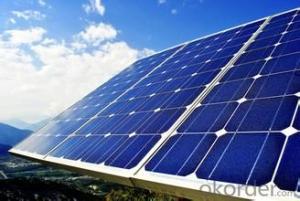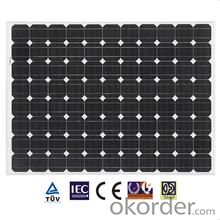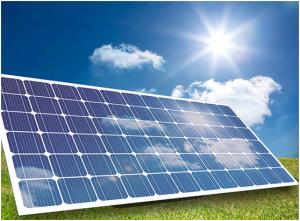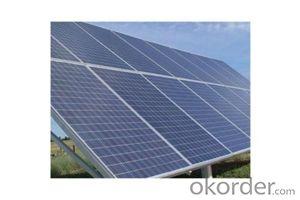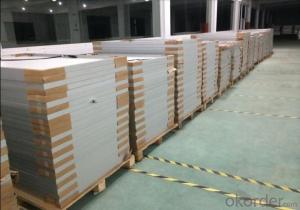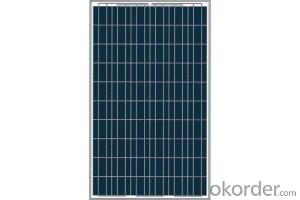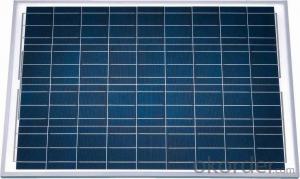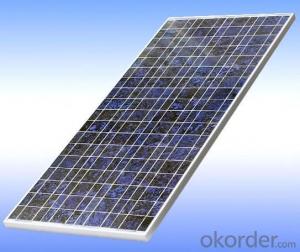Best Solar Panels for Home Use - 210W Poly Solar Photovoltaic Panel CE TUV UL Certificate
- Loading Port:
- Shanghai
- Payment Terms:
- TT OR LC
- Min Order Qty:
- 500 watt
- Supply Capability:
- 50000 watt/month
OKorder Service Pledge
OKorder Financial Service
You Might Also Like
Introduction
High efficient high reliable monocrystalline silicon solar cells ensure our product output stability
Unique frame design to reinforce sealing and to prevent freezing and warping
High transparency low iron tempered glass with enhanced stiffness and impact resistance
Advanced EVA encapsulation system with triple layer back sheet meets the most stringent safety requirements for high voltage operation Innovative and environmentally friendly packing
suggestied application
home lighting business lighting,
Garden lighting, pavement lighting
Farmer household lighting
Decorative water pump
Traffic signal lighting
industry area
business area
Solar Power Plant, Solar House
Product features
The modules are made of Monocrystalline or Polycrystalline Silicon cell.
Materials and color of the solar panel frame: Clear anodized aluminum alloy type 6063T5 Universal frame; Silver-white color;
The output connection gathers the coupling: Selects conforms to the IEC-612615; 2005, class II, IEC61730 international standard; Airtight waterproofing binding clamp;
Module seal structure: The surface is thick, the high diaphanous rate armored glass with solar cell board special-purpose 3.2mm becomes after the high temperature lamination craft. The back selects has waterproof and anti- aged performance fine TPT materials. The entire block battery board has, the waterproofing, the anti- aging airtight and so on the fine performance;
Power tolerance: +/-3%
The module bears the outside striking potential [V]: 1000V/1min
Working temperature: -40°C~+85°C
Service life [year]: It can be used more than 25 years under the environment of without acid, alkali and so on .
packing
Details: packed in international standard cartons(according to the requirements of customers ) for solar panels
Parameters

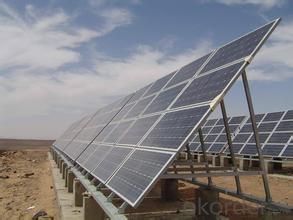
- Q: Ok so i can have a problem i have two 5 watt 2 volt solar panels a 2 volt battery and a 400 watt ac 2 volt dc inverter i believe im only getting 5 watts from from my solar panels thats the equivalent of one is there any way i could get full voltage from my solar panels without theoretically burning my wallet.. please help
- I think you need to take some basic courses on electricity. Usually, 8 volt solar panels are required to charge 2 volt batteries. The voltages of photovoltaic cells are set by the material they are made of, only current changes. If you hook up a 2 V solar panel to a 2 V battery, no current will flow, nothing would get charged. You would need some elaborate DC to DC voltage converters to charge a 2 V battery from 2 V solar panels. Solar panels can be connected in parallel or in series, as you've made the mistake of buying 2 V solar panel, you would have to wire them in series and have a charge controller that could limit the voltage of the charge. Did it ever occur to you that two 5 watt solar panels would not be able to provide the power needed by a 400 watt inverter? You're just running off your battery with your set up. Solar power is expensive power, you can not have solar without burning a hole in your wallet.
- Q: i have to do a science fair project and thought it would be cool to make a solar powered vw bus. i have 2 6volt solar panels to power a dc motor that works off of 9v 2v or 8v. i also bought a 2nd motor because the first wasnt workin for us. this one is a 3v motor. ive had them in the sun but they wont work. please help, thanks
- Make okorder
- Q: I would like to know if I had a mobile kitchen could I power it from solar panels mounted atop the vehicle (truck).(to power electric kitchen equipment, i.e. stove, deep fryer.), instead of propane…could I possibly connect the solar panels to a battery to save my generated electricity? If solar panels would not be enough power could a small windmill suffice…?
- The best way to find out is to determine the wattage of each piece of equipment you want to use and how many hours you want to use those pieces of equipment. Finally, calculate the total number of Watt-Hours you need at minimum. Then you need to research solar panels or mobile wind mills (they need to be pretty huge to get a decent amount of energy I think, so solar power is probably the way to go). You will need to figure out the efficiency of the solar panels, the size of the array, how you will turn it or if you will turn it at all (to face the sun to get the maximum energy input, or maybe to use mirrors so you don't have to turn it. Once you find a good configuration for your mobile kitchen, you need to calculate if the Watt-Hours you will generate on an average day (with average weather) is enough to power the equipment whose energy requirements you previously calculated. Then you have to keep in mind that some days will have no sun, and you may not be working on some days, but you can still capture sunlight. For each case, a large battery array will be required. If you had a guage on that array, you could also hook it up to the a small generator in case you need immediate power. It's an eco-friendly process, but the initial cost is high and it requires a lot of research and planning. This is why most people do not do it--not because they don't want free energy from the sun, but because it's not easy to start collecting that energy in an efficient way. Sorry I couldn't give you more specific numbers, but a solar panel sales agency should be able to estimate whether or not you could do it (they'd probably set it all up for you too). ^_^
- Q: Can solar panels be installed on factories or industrial buildings?
- Yes, solar panels can be installed on factories or industrial buildings. In fact, it is quite common for large-scale solar installations to be implemented on such structures, as they often have expansive rooftops or open spaces suitable for maximizing solar energy generation. Installing solar panels on factories or industrial buildings can help offset power consumption, reduce carbon emissions, and provide a sustainable source of energy for these facilities.
- Q: I want to make 2V 4.5A solar panel to charge my battery used in my RC car project. I just like to know how should I amplify the current for 4.5A. I need the total circuit diagram. Can anyone help me. Please. I need some affordable methods please.
- To increase current, you connect the cells in parallel. But I think you really mean you need 4.5 watts rather than 4.5 amps of current. For an RC car, 4.5 amps would be huge, literally a regular car battery. So I think you mean you need a 2v, 4.5w panel. That would make more sense for an RC car battery. I went on OKorder and bought a 2v, 5 watt panel for about $30.
- Q: Can solar panels be used in cold climates?
- Yes, solar panels can be used in cold climates. While the efficiency of solar panels may slightly decrease in colder temperatures, they can still generate electricity even in freezing conditions. In fact, solar panels can even benefit from the reflection of sunlight off snow, which can increase their output. Additionally, advancements in technology and the use of anti-reflective coatings have improved the performance of solar panels in cold climates.
- Q: What is the impact of roof material on solar panels' performance?
- The impact of roof material on solar panels' performance is significant. The type and condition of the roof material can affect the efficiency and effectiveness of solar panels. Certain roof materials, such as metal or asphalt shingles, are more conducive to solar panel installation and can provide a stable and durable surface for the panels. These materials typically allow for better heat dissipation and can withstand the weight of the panels. On the other hand, roofs with clay tiles or slate may require special mounting systems and can be more challenging to install solar panels on. Additionally, a damaged or deteriorating roof can pose a risk to the overall performance and lifespan of the solar panels. Therefore, it is crucial to consider the roof material and its condition when planning for solar panel installation to ensure optimal performance and longevity.
- Q: Why should I have a Generator if I have Solar Panels.....?
- Well the sun don't shine at night does it. Nor much on cloudy days. You either need a generator or a whole lot of batteries. The batteries are a pain to maintain, they're expensive to install and they have to be replaced periodically. Generator's probably a decent alternative. I'm sure most people just stay on the grid for their backup. Even better if you live in an area where you're allowed to sell back excess capacity. If you're looking to spend this kind of money anyway you could look at a household fuel cell that runs on natural gas. Awesome technology, though if you buy the unit all prebuilt and ready to go it's going to run you like 50,000 bucks.
- Q: Can solar panels be used in areas with high levels of shade or obstruction?
- Solar panels are not very efficient in areas with high levels of shade or obstruction as they rely on direct sunlight to generate electricity. However, there are certain technologies and panel designs available that can still produce energy in shaded areas to some extent, although their overall efficiency may be reduced.
- Q: How many solar panels have ah?
- Classification of solar cells: Currently on the market of solar cells into amorphous silicon and crystalline silicon. Crystalline silicon can be divided into polysilicon and monocrystalline silicon. From the photoelectric conversion efficiency of the three materials is: monocrystalline silicon (up to 17%)> polysilicon (12 ~ 15%)> amorphous silicon (about 5%).
Send your message to us
Best Solar Panels for Home Use - 210W Poly Solar Photovoltaic Panel CE TUV UL Certificate
- Loading Port:
- Shanghai
- Payment Terms:
- TT OR LC
- Min Order Qty:
- 500 watt
- Supply Capability:
- 50000 watt/month
OKorder Service Pledge
OKorder Financial Service
Similar products
Hot products
Hot Searches
Related keywords
